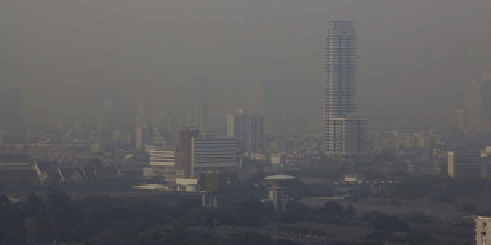Geoscience Reference
In-Depth Information
(a)
(b)
Figure 8.12.
Air pollution in (a) Taipei, Taiwan, on July 12, 2009.
C
Christopher Rawlins/Dreamstime.com and
(b) Bangkok, Thailand, on March 11, 2010.
C
Anthony Aneese Totah, Jr./Dreamstime.com.
and metallurgy plants exacerbated pollution. During
World War II, much of Osaka was leveled, decreas-
ing pollution temporarily. However, following the war,
industry rebounded, and the population and number
of vehicles increased. By the early 1970s, Osaka,
Kobe, and Kyoto had merged into a large metropoli-
tan region with heavy smoke and vehicle pollution.
Tokyo, which had also grown since the late 1800s,
similarly experienced pollution problems, mostly from
vehicles.
In 1960, the city of Ube, in southern Japan, passed
regulations controlling soot and smoke. The success of
the regulations catalyzed a national law in 1962 that
regulated some soot and smoke emissions throughout
Japan. The regulations did not solve problems immedi-
ately, however, because pollution in major cities con-
tinued to intensify.
In 1968, Japan passed a national
Air Pollution Con-
trol Law
,amended most recently in 1996. The intent
of the original law was to establish an air quality mon-
itoring system and emission standards for industrial
sources, on-road vehicles, and building construction
and demolition in order to “protect public health and
preserve the living environment.” Ultimately, the law
wasmanaged by Japan's Environment Agency, formed
in 1970, after a severe smog episode in Tokyo. The main
pollutants designated for control under the law were sul-
fur oxides, soot aerosol particles, cadmium, chlorine,
hydrogen fluoride, and lead from stationary sources;
soil dust from construction and building demolition;
and carbon monoxide, hydrocarbons, and lead from
on-road motor vehicles. In 1982, hydrocarbons from
stationary sources were also regulated under the law,
and, in 1987, a program to phase out lead in gasoline
was implemented.
In 1992, the Environment Agency (which evolved
into the Ministry of the Environment in 2001) enacted
an additional requirement to control NO
x
(g) from on-
road diesel passenger cars and all trucks, vans, buses,
and special-purpose vehicles in 196 metropolitan areas.
This law was expanded to include particulate matter
emissions in 2001, and the result was the
Automotive
NO
x
(g) and PM Law
.NO
x
(g) and PM emission stan-
dards under this law were tightened in 2005 and 2009 to
the point that they were similar to U.S. 2010 and Euro
5emission standards.
Construction machine emissions [CO(g), THCs,
NO
x
(g), PM] in Japan were controlled first in 1996,
with modifications in 2003. Nonroad vehicle emis-
sions of the same pollutants were controlled first in
2003.
Although the highest pollution levels in Japan today
are much lower than they were in the 1950s to 1970s,
increases in population since the 1980s have spread
pollution over a larger portion of the country. Health
problems related to air pollution have also been exac-
erbated by a large number of diesel vehicles and
transport of urban air pollution and Gobi Desert dust
from China.
8.2.12. Canada
Canadian air is relatively clean compared with that in
many other countries. Nevertheless, pollution is a prob-
lem in many Canadian cities, and acid deposition affects
Canadian lakes and forests.



Search WWH ::

Custom Search